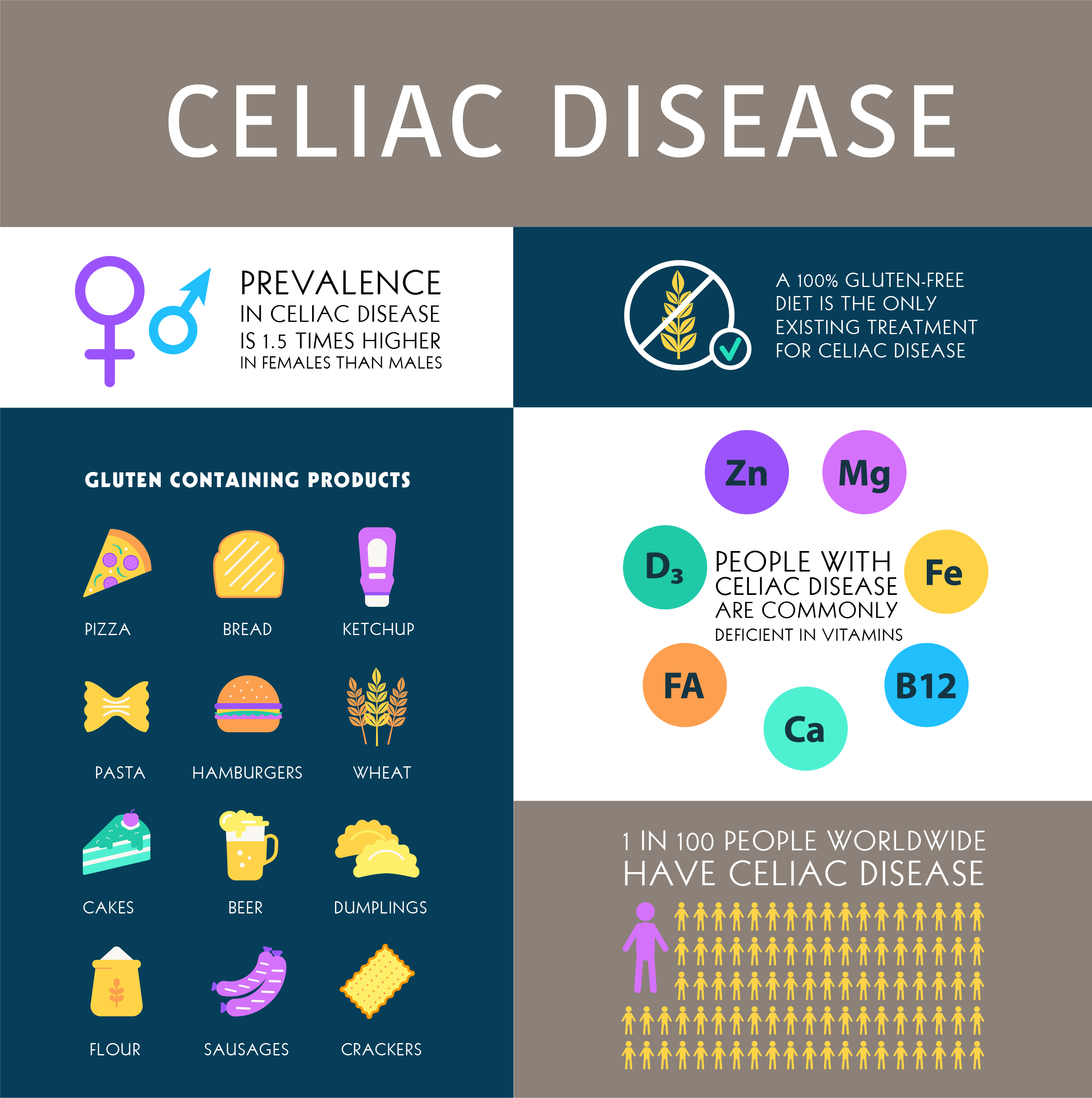Gluten-free and wheat-free diets have become increasingly popular lately, and it is estimated that around 15% of the population is actually intolerant to gluten.
Why have these dietary requirements become so prevalent all of a sudden?
For a number of reasons, such as:
- Better awareness and diagnostics mean that doctors are recognizing these dietary requirements more
- Modern varieties of wheat are completely different from the varieties that our ancestors used to grow
- People are now consuming more and more wheat-based products, many of which haven’t been prepared in a healthy way
So, is a gluten-intolerance and a wheat-intolerance the same thing?
Definitely not. Although the two terms are often used interchangeably, there are some big differences between the two…
What Exactly Are Gluten and Wheat?
Let’s begin by going back to basics and taking a closer look at what gluten and wheat actually are…
Wheat is a cereal grain that is milled into a flour and then used to make a variety of different foods, such as:
- Bread
- Pasta
- Noodles
- Cakes
- Snack foods
- Sauces
Gluten is a composite protein within the wheat, but can also be found in barley and rye.
Therefore, while all foods that contain wheat also contain gluten, gluten can come from sources other than wheat too.

What is a Wheat Intolerance?
A wheat intolerance, which is also referred to as a wheat sensitivity, refers to the body creating an inflammatory response when it comes across the proteins (including gluten) contained in wheat.
Symptoms don’t necessarily manifest immediately after the wheat has been eaten…
It can sometimes take up to 72 hours for symptoms to arise, and this can be diagnosing a wheat intolerance slightly tricky.
Wondering what the symptoms of a wheat intolerance are?
They vary between individuals, but often include:
- Digestive problems – such as bloating, stomach pains or IBS
- Skin problems – such as acne, eczema and rashes
- Neurological problems – such as migraines and headaches
- Fatigue – a noticeable lethargy and lack of energy
- Psychological problems – such as depression and anxiety
Is Wheat Intolerance the Same As Wheat Allergy?
A wheat intolerance is an inflammatory response, while a wheat allergy is a real allergy.
If you have a wheat allergy, you will likely experience the symptoms of this either immediately after consuming wheat, or just a few hours after.
Symptoms include:
- Skin irritations
- A blocked nose
- Watering eyes
- Difficulty breathing
- Anaphylactic shock
As you can see, the symptoms range from quite mild to life-threatening.
Fortunately, true wheat allergies are extremely rare. They are most commonly found in children, but most kids grow out of this once they reach the age of five. In some cases, the allergy does continue on into adulthood.
Wondering if wheat allergies are triggered by the gluten within wheat?
They can be, but there are around 30 other potential allergens within wheat too. This means that a wheat allergy could be caused by any of these.
What is Gluten Intolerance?
Many people think that a gluten intolerance is the same as an allergy, but this isn’t the case…
While a gluten intolerance is a physical condition, it takes place in the gut.
What causes it?
Sometimes gluten isn’t digested properly, meaning that undigested proteins enter into the intestines.
This triggers your body into treating them just like a foreign invader. This results in an irritated gut lining, as well as flattened microvilli.
What are microvilli?
They are compounds that increase the surface area of each cell, enabling them to better absorb nutrients. When these end up flattened against the wall of your intestines, your body becomes unable to properly absorb the nutrients within the food that you eat.
Symptoms of a gluten intolerance include:
- Malabsorption
- Nutritional deficiencies
- Anemia
- Neurological disorders
- Skin issues
- Chronic fatigue
- Depression and other mental health conditions
A gluten intolerance is often referred to as a non-celiac gluten sensitivity (NCGS).
What About Gluten Allergies?
Have you heard people mention gluten allergies before?
Well, let’s get one thing straight…
There’s no such thing as a gluten allergy. It is definitely not an official medical condition.
Instead, people sometimes use the phrase gluten allergy to refer to a gluten intolerance, or even to Celiac disease.
Where Does Celiac Disease Come Into All of This?
Just like a wheat allergy, Celiac disease is an official medical condition.
What exactly is it?
It is an autoimmune disorder that arises when a person who suffers from the condition eats wheat. Their body basically creates an immune response that causes it to attack its small intestines, which then damage the microvilli that line the gut.
As you know, the microvilli are essential for the body to properly absorb nutrients, meaning that those with undiagnosed Celiac disease could potentially suffer from some serious health problems in the long run.

Wondering how common Celiac disease is?
It is believed that Celiac disease affects about one in every one hundred people worldwide. However, one in eight of these people do not realize that they have it, or have not been officially diagnosed, which would be extremely problematic for them in the future.
What causes Celiac disease?
It’s hereditary, meaning that it would be in your genes and there’s not really much you can do about that.
Is there a cure?
Unfortunately not, at least not yet.
The main treatment for the disease is a gluten-free diet, which will be discussed more further down.
Diagnosing Wheat and Gluten Intolerances
As you can see, the differences between all of the intolerances and allergies mentioned above can be a little confusing.
Think you may be suffering from one?
The best way to find out for sure is by seeing your doctor, so that proper diagnostic tests can be run.
Wondering how these conditions are actually tested for?
It depends on your systems, but it usually goes as follows:
- Diagnosing Celiac disease – this is usually the first step when dealing with any of the symptoms mentioned earlier. This involves a blood screening, as well as a biopsy of the small intestine. Your doctor will also likely want to see whether your symptoms reduce or disappear if you follow a gluten-free diet for a while
- Diagnosing a wheat allergy – this is carried out in the same way that other food allergies are diagnosed, with a skin prick test or RAST. You may also need to undergo blind pacebo tests that make use of wheat
- Diagnosing a gluten intolerance/ NCGS – Celiac disease and a wheat allergy, along with other disorders that could be causing your symptoms, would first be ruled out. You would then likely need to try following a gluten-free diet for a while to see if this helps. If it does, then this may be enough to diagnose you with a gluten intolerance
All three of these conditions are medically recognized. However, there isn’t a cure, meaning that this is where gluten-free and wheat-free diets come in…
Gluten-Free and Wheat-Free Diets
With the only way to treat the above conditions being a specialized diet, and with all of the above conditions on the rise, it comes as no surprise that both gluten-free and wheat-free diets have become so prevalent.
A wheat-free diet does not contain any wheat, but can still contain rye and barley.
On the other hand, a gluten-free diet does not contain wheat, rye, barley, or anything else that contains gluten.
Does that mean that a person who requires a wheat-free diet could safely eat a gluten-free diet?
Not necessarily…
As mentioned earlier, there are around 30 potential allergens that have been identified in wheat, and gluten is only one of these. All of those other wheat-based compounds could still be used to create certain gluten-free foods, so long as the gluten itself is not used.
It works the other way too – a person requiring a gluten-free diet wouldn’t be safe eating a wheat-free diet. Those diets may still contain rye and barley, or even just the gluten from them, and this would trigger a reaction.
Don’t suffer from a wheat or gluten intolerance or allergy, but want to know whether you can still eat a gluten-free or wheat-free diet?
With these diets becoming quite trendy, so many people believe that they are the healthy way to go. They end up following a gluten-free diet, even though they don’t necessarily need to.
Although this isn’t necessarily dangerous, there are a few reasons as to why you may want to think twice about this:
- Whole wheat is a great source of dietary fiber, and the average American is already deficient in fiber. Yes, it’s possible to get this fiber from other sources, but you would need to put more effort into this
- Many bread and cereal products are fortified with important vitamins that are difficult to get elsewhere, such as the B vitamins. However, gluten-free and wheat-free products don’t tend to be fortified with these, meaning that you may need to turn to a dietary supplement
- Truly being gluten-free can be extremely difficult. Gluten is found in so many foods, from flavorings to vitamins to soy sauce, and even in toothpaste and certain medications. You may have to make quite a few lifestyle choices to go down this route
- Even though these diets are not necessarily any better for you, they will still likely end up costing quite a bit more than your regular diet
If you are just trying to eat in a healthier way, there are plenty of other ways in which you could do this so much better than following a gluten-free or wheat-free diet.
Ancient Wheat Varieties

Many experts believe that wheat itself isn’t the problem when it comes to the health conditions mentioned above.
Wheat has been feeding humans for more than 10,000 years, so something must have changed!
Well, there could be some logic behind this thinking…
The wheat varieties grown today are so different from the varieties of wheat that our ancestors used to grow. Ancient wheat is genetically different and has less chromosomes, and this makes it easier for the human body to digest. Ancient varieties have also been found to cause a lower immune reaction than today’s wheat.
While those with Celiac disease would still need to avoid these ancient wheat varieties, those with a gluten intolerance may potentially be able to slowly introduce these varieties into their diet.
Even if you don’t suffer from a gluten or wheat intolerance, ancient wheat varieties could still benefit you, as they have been proven to be far more nutritious. They contain higher levels of minerals, including selenium, zinc and copper, than modern wheat, making it no surprise that so many people now suffer from deficiencies in those minerals.
Why have the wheat varieties grown by humans changed so much over the years?
It happened quite recently, in the 60’s, with today’s wheat mostly being a form of dwarf wheat. This wheat is basically a cash crop when it comes to the high yields they provide, and this is something that ancient wheat has a hard time competing with.
Can’t find any breads available that have been made from ancient grains?
You can always buy the grains yourself, and then make your own bread.
Key grains to keep an eye out for include:
- Einkorn – one of the oldest of wheat varieties with the simplest genetic structure
- Emmer – also known as farro, emmer can be harder to find
- Spelt – can also sometimes be referred to as farro, and is quite similar to wheat in terms of flavor and gluten content
- Kamut – originated in Egypt, kamut is quite low in gluten, and has a beautiful buttery flavor
With gluten and wheat intolerances becoming so much more common, it is always useful to understand the differences between these conditions. If you think you may be suffering from any of their symptoms, it would definitely be worthwhile to pay a visit to your doctor so that you can be properly diagnosed.





